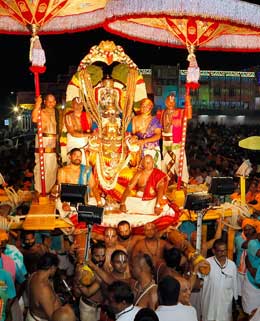The Grand Brahmotsavam Festival at Tirumala Tirupati: History, Rituals, and Significance

Brahmotsavam is a magnificent nine-day festival celebrated with exceptional enthusiasm at the renowned Tirumala Tirupati Sri Venkateshwara Temple annually. The festival derives its name from Lord Brahma, who initially inaugurated it at the Tirupati Temple, thus it is referred to as Brahmotsavam, or Brahma's Utsavam. It is deemed the most sacred of all festivals in Tirumala.
Legend has it that Lord Brahma worshipped Sri Balaji at the Tirumala Tirupathi Temple along the sacred banks of the Pushkarini River, expressing gratitude for the deity’s protection of mankind. The festival is marked by substantial traditional zeal and splendor. Devotees witness religious processions daily, where the idol of Sri Venkateshwara, also known as Balaji, is paraded through the streets in various chariots, drawing hundreds of thousands of participants seeking blessings.
Visitors often describe experiencing profound bliss and a celestial connection while attending the Brahmotsavam Festival at the Tirupati Temple, an experience they term “Vaikunth Anubhav.” Numerous rituals are performed throughout the nine days. Among them is "Ankurarpana," a significant ceremony on the eve of the festival's commencement, involving the sowing of navadhanyas (nine types of grains) in mud pots, symbolizing prosperity, fertility, and abundance.
The festival officially begins with “Dwajarohanam,” where a Garuda-emblazoned flag is hoisted on the Dhvajastambham to summon the deities to the festivities. It is believed that 30 million deities respond to this call and participate in the celebrations.
Location:
Tirumala Sri Venkateshwara Temple, Tirupati, Andhra Pradesh
Month of Celebration:
Typically between September and October.
FAQs:
What is the Brahmotsavam Festival and why is it celebrated at the Tirumala Tirupati Temple?
The Brahmotsavam Festival is a nine-day event celebrated with great fervor at the Tirumala Tirupati Sri Venkateshwara Temple. It honors Lord Brahma, who is believed to have inaugurated the festival at this temple to thank Lord Venkateshwara (Balaji) for protecting mankind. The festival includes daily processions and various rituals.
What are the main rituals and ceremonies performed during the Brahmotsavam Festival?
Key rituals include "Ankurarpana," the sowing of navadhanyas, symbolizing prosperity, and "Dwajarohanam," where a Garuda-emblazoned flag is hoisted to summon deities. Daily religious processions feature the idol of Sri Venkateshwara paraded in various chariots, attracting thousands of devotees.
When and where is the Brahmotsavam Festival held?
The Brahmotsavam Festival is held annually at the Tirumala Sri Venkateshwara Temple in Tirupati, Andhra Pradesh, typically between September and October.
What is the significance of the Ankurarpana ceremony during Brahmotsavam?
The Ankurarpana ceremony, held on the eve of the festival, involves sowing nine types of grains (navadhanyas) in mud pots. This ritual symbolizes prosperity, fertility, and abundance, marking the official start of the Brahmotsavam festivities.
How do devotees participate in the Brahmotsavam Festival at Tirupati?
Devotees participate by attending daily processions, witnessing various rituals, and seeking blessings from the deity. The festival is an opportunity for devotees to experience profound spiritual bliss, often described as “Vaikunth Anubhav,” a celestial connection with the divine.